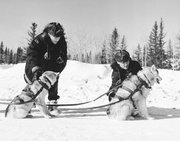 Royal Canadian Mounted Police (R.C.M.P.) These Dogs are wearing H-back
freight harnesses. Photo from 1957.
Royal Canadian Mounted Police (R.C.M.P.) These Dogs are wearing H-back
freight harnesses. Photo from 1957.
|
Dog harness, for the working dog breed of the world |
A Dog harness is similar to harness tack for horses, and varies depending on the type of use: assistance to a disabled person, for pets whose neck or throat might be sensitive to a collar, hauling a cart or sled, or pulling a human being as in skijoring or pulka.
Assistance Dog harnesses are designed with a handle for the person to grip, so that the human/Dog team may communicate as well as provide guidance (the Dog) and control (the human being). An exception to this use is in the case of Dogs who haul people in wheelchairs, although the design is similar to that used for guide Dogs.
Sled Dog harnesses vary depending on whether the Dog is hauling freight or racing. Harnesses come in three main types: the freight harness, the H-back harness, and the X-back harness. Dog sports are growing and more types of harnesses are being developed, including the Y-back style. There will probably be new variations whenever you read this.
The freight harness, often an H-back harness with a wide chestband and sometimes extra padding, is designed to help the Dog pull heavy weights efficiently, and may feature a spreader bar behind the wheel Dogs and before the sled or cart. The straps form an 'H' or ladder-like effect across the back of the Dog. These harnesses help distribute the weight of the cargo over a broader body area.
 Royal Canadian Mounted Police (R.C.M.P.) These Dogs are wearing H-back
freight harnesses. Photo from 1957.
Royal Canadian Mounted Police (R.C.M.P.) These Dogs are wearing H-back
freight harnesses. Photo from 1957.
Racing harnesses are lighter and shorter than freight harnesses. The X-back harness, so called because the straps form an 'X' across the back of the Dog, is used more frequently than the H-back, with short versions that ride farther forward on the Dog's body recently gaining in popularity.
The Y-back or hybrid harness is similar in appearance to the H-back. The tugline attaches to the harness on top of the Dog's back and stretches parallel to the ground or upwards to the skier, bicycle, or other load.
In contrast, Dogs that participate in weight pulls (as compared to a regular freight harness) will wear very heavy, padded harnesses, with broad chestbands to help spread the weight and prevent harm to the Dog.
Dog breed, Dog harness